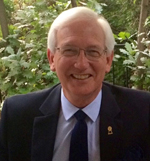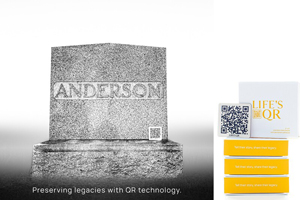Writer’s note: Disruption in the marketplace is something all industries eventually have to face. Although some may deny the data, change is inevitable. How companies and organizations deal with disruptive forces compelled me to write this piece. There is, however, an additional, more personal reason for my engaging with this topic. I worked full-time as a funeral director’s assistant for the last five years. This move gave me a unique perspective on what will become a massive issue as the baby boomers face mortality.
By Michael Brooke
In early June, I found myself at the Funeral Service Association of Canada’s annual conference held this year in Toronto. The last speaker of the event was Jim Harris. Jim is one of North America’s foremost management consultants, authors and thinkers on disruptive innovation, change and leadership. He began his presentation with a series of death-defying photos of what appeared to be people dangling off a cliff to achieve a truly great image for their Instagram feed.

Jim Harris
When Harris revealed that the photos were merely an optical illusion and not so death-defying, his audience began to understand his first critical point. He explains, “It’s all about how things are framed when viewing a situation. It determines how we react, the strategies we use and the outcomes we will get.”
According to Statistics Canada, men live to about 81 years, and women live to about 85 in this country. The first baby boomers (born in 1946) are about to turn 81 in 2027 — less than 48 months from now. For better or worse, baby boomers have dramatically impacted every stage of life they’ve passed through. Their influence on infancy, childhood, teenage years and adulthood has been overwhelming. A tsunami of change is about to hit the boomer’s final years.
While there is no doubt that funeral homes are a business, they offer a service quite different from merely buying a car. It is much more emotionally charged. People recognize the dying process, and death speaks to our humanity.

David Garvie
David Garvie spent forty-three years as a funeral director. “When it comes to funerals, there is nothing like physical presence and physical touch — even if you don’t say anything, just your presence can make a huge difference.” While he embraces the future, he tells me directly, “Physical, emotional connection is so important, and you can’t get that from technology.”

Greg Carnell
Greg Carnell is the Vice President of Operations of Carnell’s Funeral Home. Based in St. John’s, Newfoundland, Carnells has been operating since 1804. Carnell says that digital innovations have been increasingly integrated into traditional funeral practices. This trend is likely to continue in the future as technology advances and society becomes more digitally oriented. “It is essential for funeral homes to strike a balance between the significance of these technological practices and the traditional funeral practices such as cultural, religious and personal preferences that exist,” he states.
As Carnell says, “The only way to strike this balance would be to collaborate with developers to ensure that these traditions are treated with sensitivity and respect. Even as technology advances, such core traditions as public viewings, visitations, funeral services and burials will always hold a significant value that will prove difficult to replace.”

Jerry Roberts
Arbor is a major funeral chain operating in Canada, with 149 locations. Jerry Roberts, Arbor’s Vice President of Funeral Service, says that since the pandemic restrictions were lifted, many families have been choosing in-person events onsite to celebrate and memorialize their loved ones.
“We know that the physicality of a funeral service helps families grieve — together,” says Roberts.
“For those family and friends who are from around the globe or physically unable to attend, they can attend a virtual funeral from the comfort of their home — an truly valued option. It does not have the same emotional impact as in-person, but it allows people to experience the funeral and feel part of the farewell.”
In the first part of his presentation, Harris raised the idea of “reverse mentorship.” This programme requires that 50 or 60-something leaders in a company have the humility to acknowledge that 20-something workers might have the digital skills and knowledge they lack. “A shadow board of directors made up of Millennials and Generation Z can offer great insights often overlooked by traditional boards of directors.” Jim also noted that by 2026, Millennials and Gen Z will make up 75 percent of the workforce in Canada.
Harris notes that the three years of the pandemic created a decade’s worth of change. “Disruption tends to be below the radar for a long time. In December of 2019, there were 10 million users on Zoom. Then the pandemic hit, and Zoom was downloaded 300 million times in 90 days. How many companies do you know that grew their customer base 30 times in a single quarter?”

Roy Moulton
I know from personal experience that trying to film a Zoom service with a cell phone during the first few weeks of the pandemic created massive disruption. The funeral home I worked at immediately found a third-party video service for live streaming. Roy Moulton, General Manager of Heritage Funeral, explains, “The ability to share stories and photos readily has been well accepted. Sitting in on a funeral they otherwise would not have been able to attend has also been great.”

Lilli Vandermeer
Lilli Vandermeer of Sydney, Nova Scotia, is a funeral director at Forest Haven Memorial Gardens. “Nothing can replace the spiritual and emotional experience of the ritualized send-off,” she says. “Using digital innovations is like using a tool. If it’s the right tool for the job, it augments and enhances the overall scene and won’t steal the show.”
Vandermeer says there is balance, and a good funeral director will explain the importance of ritual and why the family needs it. “It doesn’t have to be a full service at a church to ritualize someone; it only requires intent and following through. Using technology will enable funeral directors to organize and enhance their services, streamlining old systems and keeping up with modern expectations.”
Brad Jones, general manager at Ridley Funeral Home, believes that digital will eventually outweigh traditional funeral practices. “I think that we as people need to embrace our human side and be able to embrace each other on our road to healing,” he says. Adding, “I think we have seen an increase in the need for counselling with the loss of viewing the deceased and celebrating them. This process brings people together and gives you the support you need.”
“People, in general, do not feel the need to come together “face to face” like in the past,” says John Cunningham of Community Alternative Funeral Services in Peterborough. “Electronic communication is gradually replacing person-to-person interactions, and I suspect grieving is done in a more solitary fashion.”
Arbor’s Roberts says, in particular, that social media is seamlessly woven into Millennials and Gen Z’s grieving process, including how they remember and commemorate their loved ones. “We have seen many families post the news of a loved one’s passing using Sharing Memories on their socials, allowing more people to grieve collectively.”

Diana Robinson
Diana Robinson is a former funeral director who now specializes in celebration of life services. She believes one can preserve rituals and embrace technology. “One can value rituals and not value traditional funeral practices at the same time. I see new death rituals being born every day, and for me, those are intrinsically about offering high standards of service, which include the latest and best technology offerings.”
As Harris showed slides of the savings in working from home (about $18,000 net gain for the average worker) and the massive move to online shopping, I sensed the atmosphere was changing. By pointing out that disruption cannot be ignored no matter what industry you work in, his words were having an impact. As the funeral directors sat contemplating the changes, it reminded me of one of the most famous authors to write about death: Elizabeth Kubler Ross and her book “On Death and Dying.”
When seen through the prism of disruption, Kubler-Ross’s philosophy makes things crystal clear.
Her five stages of grief include denial, anger, bargaining, depression and acceptance. They mirror what happens to companies that ignore the disruption right under their noses.
1. Denial: Initial Resistance and Ignoring Warning Signs
In the face of disruption, businesses may initially deny the gravity of the situation. This stage often involves a reluctance to acknowledge market changes, clinging to outdated strategies, and underestimating the potential impact. However, denial can be detrimental to long-term success. Savvy organizations recognize the importance of vigilance, staying attuned to emerging trends, and acknowledging warning signs to avoid being blindsided.
Harris points out that Uber is worth more than all the cab companies in North America combined. “While the other taxi companies all have billions of dollars in assets, Uber doesn’t own a single vehicle.” A widely distributed app is a vast multiplier worth more than a tangible asset. As Jim explains, “A CEO of a cab company came up to me and said they were spending a quarter of a million dollars on a new app. But I have no real interest in downloading multiple taxi apps.”
2. Anger: Reactive Measures and Lashing Out
Once the denial phase fades, businesses may become angry when confronted with disruption. This stage is characterized by frustration, blaming external factors, and sometimes directing anger internally. Outbursts, resistance to change, and a desire to maintain the status quo can hinder progress. Instead, businesses should channel their anger into constructive avenues, such as conducting thorough market analyses, embracing innovation, and fostering a culture of open dialogue and collaboration.
Harris tells the funeral directors they would be wise to work together to create a multilingual and multicultural app that could help people navigate the world of funeral services rather than come up with hundreds of different apps separately.
“So many organizations get tied to the current form of their business. But it is the function that is important.” As he points out – the function of banking is essential, but the current form (i.e., bank) is not. The fastest-growing bank in Brazil does not have a single branch. It’s also highly profitable because it’s not building actual banks; it’s facilitating banking.
3. Bargaining: Seeking Alternatives and Strategic Adjustments
As the reality of disruption settles in, businesses enter the bargaining stage. A search marks this phase for alternatives and attempts to negotiate a better outcome. Organizations may explore partnerships, alliances, or acquisitions to mitigate the impact of market changes. While bargaining can be a valuable coping mechanism, it is crucial to maintain a realistic perspective and ensure that strategic adjustments align with long-term goals and sustainable growth.

Alicia Vogan
Alicia Vogan works for DeMarco funeral home in Woodbridge, Ontario. “The funeral service industry recognizes the change in the atmosphere that is coming,” she says. “They openly acknowledge that the future generations are making the decisions based on convenience, personalization and low cost.” But Vogan admits it can be challenging for the industry to change.
“Approximately 15 years ago, I would watch families hold a cell phone up to a microphone so someone could speak, and now they can be visible over a screen. These moments are an opportunity to ease the transition. The job fundamentally should be helping people through an inevitable albeit difficult experience; if I can make it easier, more meaningful, and more supportive, I will!”
Harris asks the gathering, “How could funeral homes facilitate incredible experiences for customers who need to memorialize their family members?” He gets them to think about a “value vortex.” What was once a premium over time gets commodified, and the only way to counter the effects of the vortex is to create new products and services that add value.
 I met Jennifer Blakeley at the conference, who was showcasing her new company Life’s QR. While QR codes have been around for quite some time, it’s only recently that things are starting to take off. The company offers a friendly and straightforward interface for people who want to memorialize their loved ones. Social media and online memorial platforms, including Life’s QR Memorials, have transformed the grieving process and how people remember and commemorate loved ones.
I met Jennifer Blakeley at the conference, who was showcasing her new company Life’s QR. While QR codes have been around for quite some time, it’s only recently that things are starting to take off. The company offers a friendly and straightforward interface for people who want to memorialize their loved ones. Social media and online memorial platforms, including Life’s QR Memorials, have transformed the grieving process and how people remember and commemorate loved ones.
Blakeley believes that technology can enable connections and reach a broader audience. “This allows distant friends and family to participate in remembering the departed, fostering a sense of community and support.” Along with connection, technology provides continuous remembrance. “Online platforms offer dedicated spaces for ongoing remembrance, allowing for the celebration of birthdays, anniversaries, and other significant dates.”
Harris notes that as the demographics of Canada change, so do the cultural differences around death. “The question arises — what are you going to do about it?’ David Garvie explains that there is an opportunity to reach out to various communities to discuss death and dying. “Some of these communities are very reluctant to talk about death. How can we use technology to reach these people and connect them with the appropriate information?”
4. Depression: Navigating Challenges and Adapting to New Realities
In the face of persistent disruption, businesses may experience depression characterized by a sense of loss, decreased motivation, and uncertainty about the future. This stage can be particularly challenging, requiring resilience and a proactive mindset. Successful businesses acknowledge the need for change, foster a culture of agility, and invest in reskilling employees to adapt to new realities. Seeking support from industry peers, consultants, or professional networks can also provide valuable insights and rejuvenate morale.
I had the opportunity to interview Jim Harris a week after the conference. I wanted to drill down on the five elements of disruption. But just as important, I wanted his views on the final stage — acceptance and what comes next.
“When it comes to the case of the recording industry, it wasn’t anyone in the music industry that created a sustainable business model — it was Apple and Spotify. The entire industry was so caught up in the first four stages of grief; they could not create any constructive response to the environmental change.
Harris points out that the current form of how we remember people is changing. “If the funeral industry is saying ‘we are bricks and mortar with black suits and we are respectful of your grief, then they have to be attuned to the new ways in which people wish to pay tribute to their loved ones.”
In Canada, Harris sees the larger funeral operators setting up a digital team (if they haven’t already) to support the efforts of the dozens of funeral homes in their roster. “As the team proves its worth and gets more traction, it can be scaled up.”
One anonymous funeral owner believes larger funeral homes seemed to be embracing the technology available faster than the small-town funeral homes. “Online arrangements, AI intelligence, and online selection of caskets/urns/jewelry and other funeral products are appreciated by some families. Our small town still values a person that answers the phone when they call and greets them when they walk through the door. Certainly, moving forward, the expectation heads in an online direction, and we are open to embracing it when it feels like that is what our community prefers.”
When I asked what the independent funeral homes should do, Harris said they must band together and create their digital team. “The team would serve all those who were part of the group, and they would have the same kind of scale the bigger players have.”
I queried Harris about where he felt the funeral services industry was going. “There’s a saying that the future is here already; it’s just not evenly distributed.” He then pointed out that 90 percent of new car sales in Norway come with a plug, and it’s at 13 percent in Canada.
He quickly points out that not everyone will embrace the new when it comes to funerals. “It’s important to note that some people will want a traditional funeral. But if you want to thrive, you have to see which way the wind is blowing, understand how customer expectations are changing and align your business accordingly.” Harris believes that you must start at the edges and implement changes gradually. “Make low-risk bets and evaluate. Start very small and grow things organically.”
As DeMarco’s Vogan explains, “The benefit of technology at the moment is low cost. An open mind and the ability to be comfortable embracing change are paramount. When Baby Boomers are no longer making the funeral arrangements and when those Boomers are no longer managing the industry, change will start to filter in.”
5. Acceptance: Embracing Change and Pursuing Opportunities
The final stage of grief, acceptance, is where businesses fully recognize the inevitability of disruption and proactively embrace change. Instead of viewing disruption as a threat, successful organizations perceive it as an opportunity for growth and innovation. This stage involves strategic planning, diversification, and a commitment to continuous learning and adaptation. Embracing emerging technologies, prioritizing customer needs, and fostering an agile organizational culture contribute to sustained success amid marketplace disruption.
“Technology within the funeral industry needs to be embraced, mainly if we are to be perceived by the public as a profession that is willing to evolve and keep current with the times rather than a profession that refuses to allow itself to advance and meet the desires of an ever-changing society,” says David Garvie.
Garvie recognizes that people will look elsewhere for funeral services if they refuse to engage with new forms of societal and funeral technology. He acknowledges that the industry must continue to provide relevant and meaningful services and products. “But, we must never forget that as funeral professionals, we still have a primary responsibility towards the individuals we serve, that being to not just solely cater to their wants, but rather to meet their needs.”
“Most people who come to us for help when someone they love and care about has died are not just looking for a means of disposing of their deceased family member but rather seeking help in reconciling their grief issues, issues that many of them may not fully understand themselves or know how to resolve. This is where it is important for us not to forget the “why” of what we do.”


